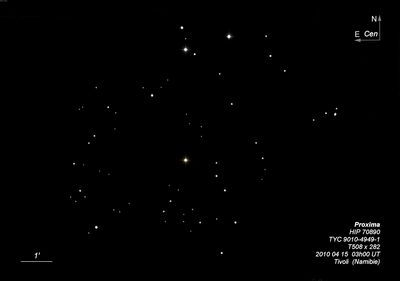Toliman (α Centauri) - It is the brightest star in the constellation and the third brightest star in the sky after Sirius and Canopus. However, it is located quite far south and can only be seen just above the horizon during culmination from 25 degrees north latitude. At a distance of 4.36 light-years, it is our closest star visible to the naked eye. In reality, it consists of two yellow components with magnitudes of 0.1 and 1.3, which can usually be easily distinguished even with a small telescope - at the turn of the millennium, their separation reached 14.1". In 2035, this distance will only decrease to 2 arc seconds. Their mutual orbital period around the common center of mass is 80 years. The α Centauri system is actually our closest stellar system. However, our closest star is actually a red dwarf with a magnitude of 10.7 called Proxima Centauri, which is also physically related to this system.
Hadar (β Centauri) - or also known as Agena. With its magnitude of 0.9, it is the 10th brightest star in the sky. Together with the star Toliman, which is only four and a half degrees away, it forms a good reference point for identifying the Southern Cross and prevents its confusion with the so-called False Cross, which is formed by the stars of the Keel and the Sail. Although this blue-white supergiant is fainter in the sky compared to Toliman, it is located about 100 times further away. Its absolute magnitude reaches -5.5. If it were located in the place of Toliman, it would have an apparent magnitude of about -10!
3 Cen - A remarkable pair of unequally bright pale blue stars with magnitudes of 4.5 and 6, which are separated by 7.9".
4 Cen - An attractive double star composed of a pale blue 4.7 magnitude component and a gray-white component with a magnitude of 8.4, which is located at a distance of 14.9".
R Cen - The variable star of Mira type is located between the stars α and β Centauri. Its brightness varies from 5.3mag to 11.8mag over a period of 546 days.
Herschel 4423 - An attractive pair of yellow stars dominates a relatively sparse field of stars. The components have apparent magnitudes of 6.9 and 7.2, and they are separated by 2.4 arcseconds.
Proxima Centauri - 
In 1915, R. T. Innes measured the proper motions of stars around α Centauri. At a distance of 2.2 arc degrees southwest of this star, he found a star with a brightness of 10.7 mag, which was moving in the same direction and at the same speed as both components of α Centauri. This red dwarf is actually our closest star to the Sun, only 4.25 light-years away. It is likely part of the α Centauri system, although it orbits at a very large distance. In a few thousand years, when it passes Toliman, it will no longer be our closest star. Proxima, which means "closest" in Latin, occasionally brightens by more than half a magnitude and usually returns to its original brightness within half an hour. Proxima Centauri is a small star, with a mass only 1/10 of the Sun's mass, and it is very faint, shining less than 0.0008 times the brightness of the Sun.